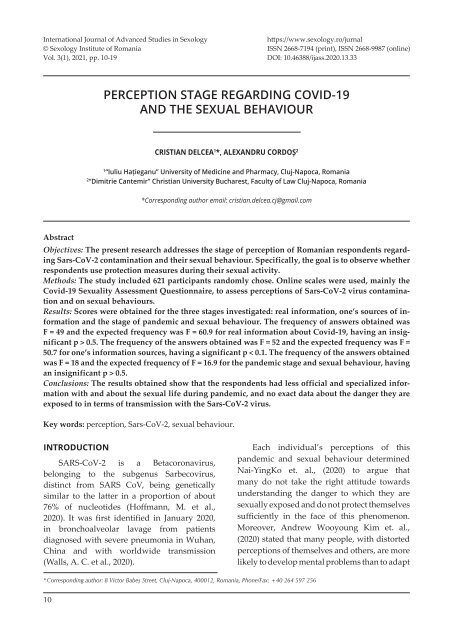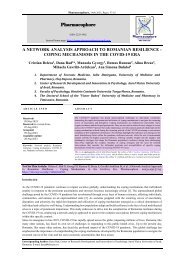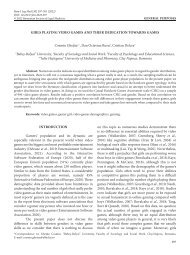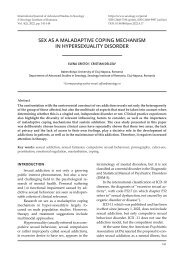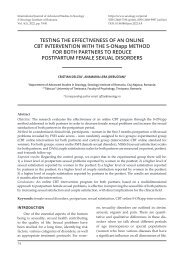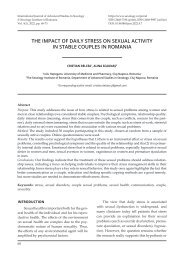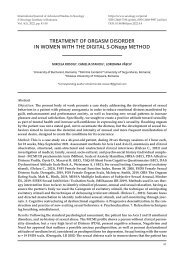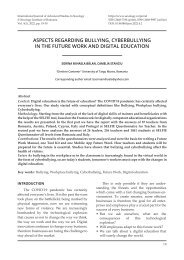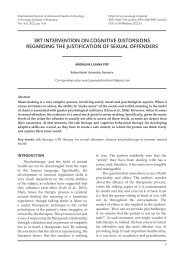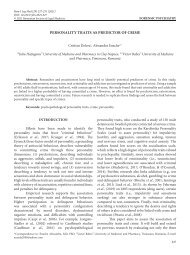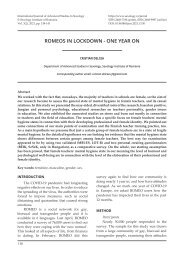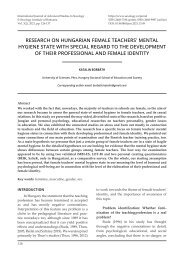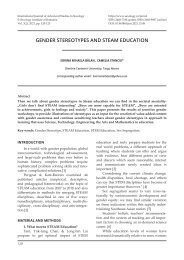10-19 Delcea and Cordos - Perception stage regarding Covid-19
PERCEPTION STAGE REGARDING COVID-19 AND THE SEXUAL BEHAVIOUR Cristian Delcea1*, Alexandru Cordoș2 1“Iuliu Hațieganu” University of Medicine and Pharmacy, Cluj-Napoca, Romania 2“Dimitrie Cantemir” Christian University Bucharest, Faculty of Law Cluj-Napoca, Romania *Corresponding author: cristian.delcea.cj@gmail.com International Journal of Advanced Studies in Sexology Volume 3, 2021 | Issue 1, Pages 10-19 | ISSN 2668-7194 (print), ISSN 2668-9987 (online) Citation: Delcea C.,*, Cordoș A., (2021). Perception Stage Regarding Covid-19 And the Sexual Behaviour. Int J Advanced Studies in Sexology. Vol. 3, Issue 1, pp. 10-19. Sexology Institute of Romania. DOI: 10.46388/ijass.2020.13.33 Abstract Objectives: The present research addresses the stage of perception of Romanian respondents regarding Sars-CoV-2 contamination and their sexual behaviour. Specifically, the goal is to observe whether respondents use protection measures during their sexual activity. Methods: The study included 621 participants randomly chose. Online scales were used, mainly the Covid-19 Sexuality Assessment Questionnaire, to assess perceptions of Sars-CoV-2 virus contamination and on sexual behaviours. Results: Scores were obtained for the three stages investigated: real information, one’s sources of information and the stage of pandemic and sexual behaviour. The frequency of answers obtained was F = 49 and the expected frequency was F = 60.9 for real information about Covid-19, having an insignificant p > 0.5. The frequency of the answers obtained was F = 52 and the expected frequency was F = 50.7 for one’s information sources, having a significant p < 0 xss=removed xss=removed> 0.5. Conclusions: The results obtained show that the respondents had less official and specialized information with and about the sexual life during pandemic, and no exact data about the danger they are exposed to in terms of transmission with the Sars-CoV-2 virus. Keywords: perception, Sars-CoV-2, sexual behaviour.
PERCEPTION STAGE REGARDING COVID-19 AND THE SEXUAL BEHAVIOUR
Cristian Delcea1*, Alexandru Cordoș2
1“Iuliu Hațieganu” University of Medicine and Pharmacy, Cluj-Napoca, Romania
2“Dimitrie Cantemir” Christian University Bucharest, Faculty of Law Cluj-Napoca, Romania
*Corresponding author: cristian.delcea.cj@gmail.com
International Journal of Advanced Studies in Sexology
Volume 3, 2021 | Issue 1, Pages 10-19 | ISSN 2668-7194 (print), ISSN 2668-9987 (online)
Citation: Delcea C.,*, Cordoș A., (2021). Perception Stage Regarding Covid-19
And the Sexual Behaviour. Int J Advanced Studies in Sexology. Vol. 3, Issue 1, pp. 10-19. Sexology Institute of Romania.
DOI: 10.46388/ijass.2020.13.33
Abstract
Objectives: The present research addresses the stage of perception of Romanian respondents regarding Sars-CoV-2 contamination and their sexual behaviour. Specifically, the goal is to observe whether respondents use protection measures during their sexual activity.
Methods: The study included 621 participants randomly chose. Online scales were used, mainly the Covid-19 Sexuality Assessment Questionnaire, to assess perceptions of Sars-CoV-2 virus contamination and on sexual behaviours.
Results: Scores were obtained for the three stages investigated: real information, one’s sources of information and the stage of pandemic and sexual behaviour. The frequency of answers obtained was F = 49 and the expected frequency was F = 60.9 for real information about Covid-19, having an insignificant p > 0.5. The frequency of the answers obtained was F = 52 and the expected frequency was F = 50.7 for one’s information sources, having a significant p < 0 xss=removed xss=removed> 0.5.
Conclusions: The results obtained show that the respondents had less official and specialized information with and about the sexual life during pandemic, and no exact data about the danger they are exposed to in terms of transmission with the Sars-CoV-2 virus.
Keywords: perception, Sars-CoV-2, sexual behaviour.
You also want an ePaper? Increase the reach of your titles
YUMPU automatically turns print PDFs into web optimized ePapers that Google loves.
International Journal of Advanced Studies in Sexology<br />
© Sexology Institute of Romania<br />
Vol. 3(1), 2021, pp. <strong>10</strong>-<strong>19</strong><br />
https://www.sexology.ro/jurnal<br />
ISSN 2668-7<strong>19</strong>4 (print), ISSN 2668-9987 (online)<br />
DOI: <strong>10</strong>.46388/ijass.2020.13.33<br />
PERCEPTION STAGE REGARDING COVID-<strong>19</strong><br />
AND THE SEXUAL BEHAVIOUR<br />
CRISTIAN DELCEA 1 *, ALEXANDRU CORDOȘ 2<br />
1<br />
“Iuliu Hațieganu” University of Medicine <strong>and</strong> Pharmacy, Cluj-Napoca, Romania<br />
2<br />
“Dimitrie Cantemir” Christian University Bucharest, Faculty of Law Cluj-Napoca, Romania<br />
*Corresponding author email: cristian.delcea.cj@gmail.com<br />
Abstract<br />
Objectives: The present research addresses the <strong>stage</strong> of perception of Romanian respondents <strong>regarding</strong><br />
Sars-CoV-2 contamination <strong>and</strong> their sexual behaviour. Specifically, the goal is to observe whether<br />
respondents use protection measures during their sexual activity.<br />
Methods: The study included 621 participants r<strong>and</strong>omly chose. Online scales were used, mainly the<br />
<strong>Covid</strong>-<strong>19</strong> Sexuality Assessment Questionnaire, to assess perceptions of Sars-CoV-2 virus contamination<br />
<strong>and</strong> on sexual behaviours.<br />
Results: Scores were obtained for the three <strong>stage</strong>s investigated: real information, one’s sources of information<br />
<strong>and</strong> the <strong>stage</strong> of p<strong>and</strong>emic <strong>and</strong> sexual behaviour. The frequency of answers obtained was<br />
F = 49 <strong>and</strong> the expected frequency was F = 60.9 for real information about <strong>Covid</strong>-<strong>19</strong>, having an insignificant<br />
p > 0.5. The frequency of the answers obtained was F = 52 <strong>and</strong> the expected frequency was F =<br />
50.7 for one’s information sources, having a significant p < 0.1. The frequency of the answers obtained<br />
was F = 18 <strong>and</strong> the expected frequency of F = 16.9 for the p<strong>and</strong>emic <strong>stage</strong> <strong>and</strong> sexual behaviour, having<br />
an insignificant p > 0.5.<br />
Conclusions: The results obtained show that the respondents had less official <strong>and</strong> specialized information<br />
with <strong>and</strong> about the sexual life during p<strong>and</strong>emic, <strong>and</strong> no exact data about the danger they are<br />
exposed to in terms of transmission with the Sars-CoV-2 virus.<br />
Key words: perception, Sars-CoV-2, sexual behaviour.<br />
INTRODUCTION<br />
SARS-CoV-2 is a Betacoronavirus,<br />
belonging to the subgenus Sarbecovirus,<br />
distinct from SARS CoV, being genetically<br />
similar to the latter in a proportion of about<br />
76% of nucleotides (Hoffmann, M. et al.,<br />
2020). It was first identified in January 2020,<br />
in bronchoalveolar lavage from patients<br />
diagnosed with severe pneumonia in Wuhan,<br />
China <strong>and</strong> with worldwide transmission<br />
(Walls, A. C. et al., 2020).<br />
Each individual’s perceptions of this<br />
p<strong>and</strong>emic <strong>and</strong> sexual behaviour determined<br />
Nai-YingKo et. al., (2020) to argue that<br />
many do not take the right attitude towards<br />
underst<strong>and</strong>ing the danger to which they are<br />
sexually exposed <strong>and</strong> do not protect themselves<br />
sufficiently in the face of this phenomenon.<br />
Moreover, Andrew Wooyoung Kim et. al.,<br />
(2020) stated that many people, with distorted<br />
perceptions of themselves <strong>and</strong> others, are more<br />
likely to develop mental problems than to adapt<br />
*Corresponding author: 8 Victor Babeº Street, Cluj-Napoca, 400012, Romania, Phone/Fax: +40 264 597 256<br />
<strong>10</strong>
<strong>Perception</strong> <strong>stage</strong> <strong>regarding</strong> <strong>Covid</strong>-<strong>19</strong> <strong>and</strong> the sexual behaviour<br />
during the p<strong>and</strong>emic. YelizKaya et. al. (2020)<br />
also pointed out that the p<strong>and</strong>emic period can<br />
affect the sexual behaviour by reducing the<br />
frequency of sexual intercourse as well as the<br />
quality of intimate life.<br />
The role of this research is to highlight<br />
the danger to which individuals are exposed<br />
to during sexual intercourse without being<br />
correctly informed about <strong>Covid</strong>-<strong>19</strong>, as well<br />
as practicing unprotected sexual behaviour<br />
that may or may not lead to contamination<br />
(Babatunde Ahonsi, 2020). Up to date studies<br />
concentrated more on mortality among men<br />
due to <strong>Covid</strong>-<strong>19</strong> <strong>and</strong> who had comorbidities<br />
(Derek M. Griffith, 2020), on those with low<br />
paid professions, exposed to contamination<br />
(Baker P et. al., 2020), on gender (Sharma G.<br />
et. al., 2020) <strong>and</strong> on other severe forms (Meng<br />
Y., 2020), but less studies or not at all, on the<br />
evaluation of perceptions about <strong>Covid</strong>-<strong>19</strong><br />
<strong>and</strong> sexual behaviour in individuals without<br />
medical diseases or other associated forms.<br />
Thus, in this paper, the perceptions of<br />
individuals <strong>regarding</strong> the Sars-CoV-2 virus,<br />
the real information about contamination as<br />
well as their sexual behaviour is presented.<br />
The main interest is in finding out how<br />
individuals are informed from real sources,<br />
what perceptions they have about <strong>Covid</strong>-<strong>19</strong><br />
<strong>and</strong> how they behave, from a sexual point of<br />
view, during the p<strong>and</strong>emic. For this matter,<br />
a st<strong>and</strong>ardized tool was used, in order to<br />
measure the respondents’ perceptions on the<br />
transmission of the virus in their intimate<br />
lives, accurate sources of information about<br />
the Sars-CoV-2 virus <strong>and</strong> sexual behaviour.<br />
Consequently, a correlation or a discrepancy<br />
between an adaptive or maladaptive sexual<br />
behaviour was followed, during the p<strong>and</strong>emic<br />
period mediated by real information or one’s<br />
perceptions or one’s sources of information.<br />
METHOD<br />
Research objective<br />
The individuals’ sexual behaviour during<br />
the p<strong>and</strong>emic <strong>and</strong> the role of real <strong>and</strong> / or<br />
personal information in their perceptions<br />
represents the main objective.<br />
Participants<br />
Statistical data<br />
Our sample consisted of 621 participants<br />
(N = 621), with a gender mean of m = 0.7 in<br />
women <strong>and</strong> m = 0.3 in men, meaning that there<br />
was a higher percentage of women involved<br />
in research. The respondents’ average age was<br />
m = 33 years, as for the mean of professional<br />
occupation, most of our participants indicated<br />
that they are entrepreneurs (m=2.7). The level<br />
of education had an average of m = 3.33 for<br />
higher education.<br />
Inclusion/ exclusion criteria<br />
All participants included in the present<br />
research met the eligibility criteria for the study<br />
as follows: be older than the age of 18, with<br />
secondary <strong>and</strong> higher education, have started<br />
their sexual life before the p<strong>and</strong>emic <strong>and</strong> not<br />
have mental <strong>and</strong> / or personality disorders<br />
or other neuro-developmental problems or<br />
neurocognitive disorders.<br />
Description of the procedure<br />
The selection procedure for the participants<br />
was an online one, of a non-probabilistic<br />
type, based on convenience, based on an<br />
announcement on social networks, on the<br />
websites of state <strong>and</strong> private health institutions<br />
between March 22 <strong>and</strong> December 16, 2020.<br />
Ethical issues<br />
Participants eligible for this research have<br />
given their electronic agreement, in the consent<br />
form, on the purpose of the research <strong>and</strong> their<br />
participation in the testing sample, as well as<br />
issues related to 2016/679 (EU) Regulation on<br />
the protection of individuals with regard to<br />
the processing of personal data <strong>and</strong> on the free<br />
movement of such data <strong>and</strong> the Directive 95/46<br />
/ EC (General Data Protection Regulation) <strong>and</strong><br />
Law no. 506/2004 on the processing of personal<br />
data <strong>and</strong> the protection of privacy. The consent<br />
also included the fact that the research team<br />
who had the obligation to manage safely <strong>and</strong><br />
only for the specified purposes, the data provided:<br />
e-mail address (optional), social data<br />
-demog*raphic <strong>and</strong> subjective answers to questionnaires.<br />
11
DELCEA <strong>and</strong> CORDOȘ<br />
Instrument<br />
The digital form used in this research was<br />
the Questionnaire for sexuality assessment<br />
during <strong>Covid</strong>-<strong>19</strong>, (Micluția I. & <strong>Delcea</strong> C., 2020).<br />
This test was st<strong>and</strong>ardized <strong>and</strong> calibrated with<br />
specificity, during the p<strong>and</strong>emic period on the<br />
Romanian population. It has 51 items with<br />
likert type answers <strong>and</strong> the interpretation of the<br />
answers is qualitative, without a psychometric<br />
calculation, but the predominant gross answer<br />
is calculated after completion.<br />
The questionnaire includes 3 subscales that<br />
indicate: the areas of operation (professional,<br />
couple, social <strong>and</strong> educational level) of the test<br />
respondent <strong>and</strong> the manifestation of intimate<br />
activities in the p<strong>and</strong>emic sex life.<br />
Procedure<br />
The participants filled in the electronic<br />
questionnaire, accessed online, from several<br />
specialized portals, where it was hosted for<br />
people involved in the research. All participants<br />
answered the 51 items formulated in<br />
the questionnaire <strong>and</strong> then sent them to the<br />
cloud-system, where the test participants’ answers<br />
were stored.<br />
All data collected were analyzed <strong>and</strong> processed<br />
in table formatting to be entered into a<br />
statistical program called SPSS-20. Preliminary<br />
results of the statistical data indicated that<br />
the answers given by the participants were<br />
without material errors <strong>and</strong> that no item boxes,<br />
which were not fully filled in, were identified.<br />
RESULTS<br />
The present research aimed at the<br />
perception of the <strong>Covid</strong>-<strong>19</strong> virus <strong>and</strong> sexual<br />
behaviour, sexual <strong>and</strong> couple relationships,<br />
as well as the socio-human relationships<br />
during the p<strong>and</strong>emic state of emergency. The<br />
Chi-square statistical method was used. This<br />
method tests the statistical significance for the<br />
three nominal variables of the present research.<br />
The variables used were: real information <strong>and</strong><br />
sexual behaviour; own sources of information<br />
<strong>and</strong> sexual behaviour as well as the <strong>stage</strong> of the<br />
p<strong>and</strong>emic <strong>and</strong> sexual behaviour.<br />
From the table below one can see the<br />
frequency of answers given by participants<br />
(f, 49) <strong>and</strong> the frequency of expected results<br />
(f, 60.9), which indicates a discrepancy of f,<br />
-11.9. Table 1 shows the calculation between<br />
the results obtained from the real information<br />
about <strong>Covid</strong>-<strong>19</strong> <strong>and</strong> sexual behaviour.<br />
The second table shows the results obtained<br />
at the Pearson coefficient on real information<br />
<strong>and</strong> sexual behaviour during the p<strong>and</strong>emic.<br />
The scores obtained (F, 4.2; df, 2; Sig.,<br />
0.123) do not indicate a significant correlation<br />
(p > 0.5), which shows that there is not always a<br />
correct attitude <strong>regarding</strong> the adaptation of the<br />
Table 1. Current <strong>and</strong> expected frequency <strong>and</strong> difference in sexual behaviour results<br />
<strong>and</strong> actual <strong>Covid</strong>-<strong>19</strong> information. Crosstab<br />
RealInfoCOVID<br />
Total<br />
0<br />
1<br />
2<br />
SexualPractice<br />
Total<br />
0 1<br />
Count 300 49 349<br />
Expected Count 288,1 60,9 349,0<br />
Residual 11,9 -11,9<br />
Count 513 122 635<br />
Expected Count 524,2 1<strong>10</strong>,8 635,0<br />
Residual -11,2 11,2<br />
Count 214 46 260<br />
Expected Count 214,6 45,4 260,0<br />
Residual -,6 ,6<br />
Count <strong>10</strong>27 217 1244<br />
Expected Count <strong>10</strong>27,0 217,0 1244,0<br />
12
<strong>Perception</strong> <strong>stage</strong> <strong>regarding</strong> <strong>Covid</strong>-<strong>19</strong> <strong>and</strong> the sexual behaviour<br />
Table 2. The value of the coefficient (Pearson), the degrees of freedom<br />
<strong>and</strong> the bidirectional significance of the results obtained <strong>regarding</strong> the real information<br />
<strong>and</strong> the sexual behaviour of the respondents. Chi-Square Tests<br />
Value df Asymp. Sig. (2-sided)<br />
Pearson Chi-Square 4,<strong>19</strong>8 a 2 0,123<br />
Likelihood Ratio 4,324 2 0,115<br />
Linear-by-Linear Association 1,806 1 0,179<br />
N of Valid Cases 1244<br />
a. 0 cells (0,0%) have expected count less than 5. The minimum expected count is 45,35.<br />
participants to those expressed <strong>regarding</strong> real<br />
information <strong>and</strong> their intimate life.<br />
Figure 1 below can reinforce the results in<br />
the table above <strong>regarding</strong> what it is expressed<br />
<strong>and</strong> what is done, even if the information is<br />
expressed correctly. The result with number<br />
0 indicates the correct information about<br />
<strong>Covid</strong>-<strong>19</strong> <strong>and</strong> the results with number 1 indicate<br />
how the participants report to SARS-CoV-2<br />
Viral RNA. The three types of real information<br />
(official WHO information) are: virus contact,<br />
hygiene <strong>and</strong> protection.<br />
In the table below we can see a frequency<br />
of answers given by participants (f, 52) <strong>and</strong> the<br />
frequency of expected results (f, 50.7), which<br />
indicates a discrepancy of f, 1.3. Table 3 shows<br />
the calculation between the results obtained<br />
from one’s own information about <strong>Covid</strong>-<strong>19</strong><br />
<strong>and</strong> sexual behaviour.<br />
Table 4 shows the results obtained for the<br />
Pearson coefficient <strong>regarding</strong> the respondents’<br />
own information <strong>and</strong> their sexual behaviour<br />
during the p<strong>and</strong>emic. The scores obtained (F,<br />
23,271; df, 8; Sig., 0.003) indicate a significant<br />
correlation (0.003 p < 0.1), which shows that<br />
there always exists a perspective of thing<br />
offered by individual sources of information<br />
<strong>and</strong> not by real sources of information,<br />
<strong>regarding</strong> the p<strong>and</strong>emic <strong>and</strong> their intimate life.<br />
A significant score of 0.002 p < 0.1 can also be<br />
observed at LikelihoodRatio, but at Linear-by-<br />
Linear Association the score obtained (0.133 p<br />
> 0.1) is not significant enough.<br />
Figure 2 shows the results obtained for<br />
sexual behaviour <strong>and</strong> one’s sources of information.<br />
For example, the number 0 indicates the<br />
respondents’ own information about <strong>Covid</strong>-<strong>19</strong><br />
<strong>and</strong> the results with the number 1 indicate<br />
Figure 1. The difference between the real information about <strong>Covid</strong> <strong>19</strong> <strong>and</strong> sexual practices<br />
13
DELCEA <strong>and</strong> CORDOȘ<br />
Table 3. Current <strong>and</strong> expected frequency <strong>and</strong> the difference in sexual behaviour results<br />
<strong>and</strong> own sources of information on <strong>Covid</strong>-<strong>19</strong>. Crosstab<br />
SourceInfo<br />
Total<br />
0<br />
1<br />
2<br />
3<br />
4<br />
5<br />
6<br />
7<br />
8<br />
SexualPractice<br />
Total<br />
0 1<br />
Count 241 52 293<br />
Expected Count 242,3 50,7 293,0<br />
Residual -1,3 1,3<br />
Count 57 5 62<br />
Expected Count 51,3 <strong>10</strong>,7 62,0<br />
Residual 5,7 -5,7<br />
Count 464 117 581<br />
Expected Count 480,5 <strong>10</strong>0,5 581,0<br />
Residual -16,5 16,5<br />
Count 5 1 6<br />
Expected Count 5,0 1,0 6,0<br />
Residual ,0 ,0<br />
Count 5 0 5<br />
Expected Count 4,1 ,9 5,0<br />
Residual ,9 -,9<br />
Count 34 6 40<br />
Expected Count 33,1 6,9 40,0<br />
Residual ,9 -,9<br />
Count 179 25 204<br />
Expected Count 168,7 35,3 204,0<br />
Residual <strong>10</strong>,3 -<strong>10</strong>,3<br />
Count 9 0 9<br />
Expected Count 7,4 1,6 9,0<br />
Residual 1,6 -1,6<br />
Count 0 2 2<br />
Expected Count 1,7 ,3 2,0<br />
Residual -1,7 1,7<br />
Count 994 208 1202<br />
Expected Count 994,0 208,0 1202,0<br />
Table 4. The (Pearson) coefficient value of the degrees of freedom<br />
<strong>and</strong> the bidirectional significance of the results obtained on one’s sources of information<br />
<strong>and</strong> the sexual behaviour of the respondents. Chi-Square Tests<br />
Value df Asymp. Sig. (2-sided)<br />
Pearson Chi-Square 23,271 a 8 ,003<br />
Likelihood Ratio 24,069 8 ,002<br />
Linear-by-Linear Association 2,254 1 ,133<br />
N of Valid Cases 1202<br />
a. 7 cells (38,9%) have expected count less than 5. The minimum expected count is,35.<br />
14
<strong>Perception</strong> <strong>stage</strong> <strong>regarding</strong> <strong>Covid</strong>-<strong>19</strong> <strong>and</strong> the sexual behaviour<br />
Figure 2. Comparisons between <strong>Covid</strong>-<strong>19</strong> from one’s sources of information <strong>and</strong> sexual behaviour<br />
how the participants report to SARS-CoV-2<br />
Viral RNA. As one can see, the main sources<br />
of information about sex (kissing, touching,<br />
oral sex, anal sex, vaginal sex, sex with sex toys<br />
<strong>and</strong> masturbation) are indexed during the p<strong>and</strong>emic<br />
(Figure 2).<br />
In the table 5, one can observe a frequency<br />
of answers given by the participants (f, 18) <strong>and</strong><br />
the frequency of the expected results (f, 16.9),<br />
which indicates a discrepancy of f, 1.1. Table<br />
5 shows the calculation between the results<br />
obtained at the p<strong>and</strong>emic <strong>stage</strong> <strong>and</strong> sexual<br />
behaviour (Table 5).<br />
The table below shows the results obtained<br />
at the Pearson coefficient <strong>regarding</strong> the<br />
respondents’ own information <strong>and</strong> their sexual<br />
behaviour during the p<strong>and</strong>emic. The scores<br />
obtained (F, 6.351; df, 2; Sig., 0.042) do not<br />
indicate a significant correlation (p > 0.5), which<br />
shows that there is no correlation between<br />
one’s own information, sexual behaviour <strong>and</strong><br />
the <strong>stage</strong> of the p<strong>and</strong>emic. As one can see, the<br />
Table 5. The current frequency <strong>and</strong> the expected frequency as well as the difference<br />
in the results referring to sexual behaviour <strong>and</strong> the <strong>stage</strong> of the p<strong>and</strong>emic. Crosstab<br />
P<strong>and</strong>emic Status<br />
Total<br />
1<br />
2<br />
3<br />
SexualPractice<br />
Total<br />
0 1<br />
Count 79 18 97<br />
Expected Count 80,1 16,9 97,0<br />
Residual -1,1 1,1<br />
Count 652 118 770<br />
Expected Count 636,1 133,9 770,0<br />
Residual 15,9 -15,9<br />
Count 300 81 381<br />
Expected Count 314,8 66,2 381,0<br />
Residual -14,8 14,8<br />
Count <strong>10</strong>31 217 1248<br />
Expected Count <strong>10</strong>31,0 217,0 1248,0<br />
15
DELCEA <strong>and</strong> CORDOȘ<br />
results from LikelihoodRatio (0, 0045 = p > 0.5)<br />
<strong>and</strong> Linear-by-Linear Association (0, 077 = p<br />
> 0.5) increase at the significance thresholds,<br />
which shows that there aren’t any significant<br />
in the results presented below (Table 6).<br />
Figure 3 shows the comparisons between<br />
the three <strong>stage</strong>s of the p<strong>and</strong>emic, during the<br />
period March <strong>and</strong> December (March 1-June;<br />
July 2-September <strong>and</strong> October 3-December).<br />
From the data below, comparisons can be<br />
seen between p<strong>and</strong>emic periods indexed with<br />
the number 0 <strong>and</strong> sexual practice indexed<br />
with the number 1. The results obtained<br />
indicate a maladaptive / reduced behavioural<br />
participation between p<strong>and</strong>emic periods (see<br />
figure 1). The more the p<strong>and</strong>emic was perceived<br />
as a danger, the less sexual or maladaptive the<br />
sexual behaviours were (Figure 3).<br />
DISCUSSIONS<br />
The sexual behaviour of the study<br />
participants was modified not according to real<br />
information about the <strong>stage</strong> of the p<strong>and</strong>emic<br />
but according to their individuals’ information<br />
about sex. The actual information about<br />
<strong>Covid</strong>-<strong>19</strong> did not change sexual behaviour for<br />
better or worse, but we have non-discriminatory<br />
results, that is, results close to the thresholds of<br />
significance.<br />
From the results obtained, it was observed<br />
that for the real information about <strong>Covid</strong>-<strong>19</strong><br />
Table 6. T he (Pearson) coefficient value of the \degrees of freedom<br />
<strong>and</strong> the bidirectional significance of the results obtained <strong>regarding</strong> the <strong>stage</strong><br />
of the p<strong>and</strong>emic <strong>and</strong> the sexual behaviour of the respondents. Chi-Square Tests<br />
Value df Asymp. Sig. (2-sided)<br />
Pearson Chi-Square 6,351 a 2 ,042<br />
Likelihood Ratio 6,216 2 ,045<br />
Linear-by-Linear Association 3,121 1 ,077<br />
N of Valid Cases 1248<br />
a. 0 cells (0,0%) have expected count less than 5. The minimum expected count is 16,87.<br />
Figure 3. Comparisons between the <strong>stage</strong> of the P<strong>and</strong>emic <strong>and</strong> sexual behaviour<br />
16
<strong>Perception</strong> <strong>stage</strong> <strong>regarding</strong> <strong>Covid</strong>-<strong>19</strong> <strong>and</strong> the sexual behaviour<br />
<strong>and</strong> sexual behaviour, the frequency of<br />
participants’ responses was lower compared<br />
to the frequency of expected responses, which<br />
indicates that respondents did not fully have<br />
accurate data on SARS-CoV-2 virus. Moreover,<br />
from the analysis of the Pearson coefficient, it<br />
is observed that the results obtained are higher,<br />
emphasizing that these are not significant.<br />
When speaking about own sources of<br />
information on sexual life, one can notice that<br />
the frequency of respondents’ responses is even<br />
higher than the frequency of expected responses,<br />
which indicates that the decision of an adaptive<br />
or maladaptive sexual act is mediated not by<br />
real information about the danger to which a<br />
participant is exposed during the sexual act,<br />
but from information from one’s sources. The<br />
values of the correlation coefficient indicate a<br />
significant result compared to the data from<br />
real information <strong>and</strong> sexual behaviour.<br />
The results obtained during the p<strong>and</strong>emic<br />
are much higher than those checked by the<br />
respondents compared to the results expected,<br />
which shows that the p<strong>and</strong>emic impact<br />
marked the sexual life of each respondent.<br />
The coefficient of results was not significant,<br />
showing that there are no correlations between<br />
p<strong>and</strong>emic <strong>stage</strong>s <strong>and</strong> sexual behaviour.<br />
A similar study of Yasir Arafata, (2020)<br />
which analyzed the impact of <strong>Covid</strong>-<strong>19</strong><br />
on sexual behaviour in three countries<br />
(Bangladesh, India & Nepal) concluded that,<br />
among other expectations, in terms of p<strong>and</strong>emic<br />
sex life, one’s dysfunctional perceptions can<br />
also affect the couple’s relationship <strong>and</strong> sexual<br />
life. Another research that adds information<br />
to this research is that of GianmartinCito <strong>and</strong><br />
his colleagues (2020), who conducted an online<br />
study on 1576 respondents from Italy, who<br />
obtained a percentage of 61.2% of adaptive<br />
sexual behaviour, <strong>and</strong> the difference up to<br />
<strong>10</strong>0% had problems of adaptation to sexual life<br />
due to the catastrophic information perceived<br />
as a result of <strong>Covid</strong>-<strong>19</strong>, based on the own<br />
sources of the research participants.<br />
Other more complex population studies<br />
in France, conducted by Gouvernet, &<br />
Bonierbale (2020) on <strong>10</strong>79 subjects, of which,<br />
338 men <strong>and</strong> 741 women, identified that<br />
mental vulnerabilities doubled by other less<br />
real information about <strong>Covid</strong>-<strong>19</strong> can change<br />
maladaptive sexual behaviours. And the study<br />
conducted by L<strong>and</strong>ry, S., Chartogne, M., &<br />
L<strong>and</strong>ry, A. (2020) on 844 couples of which 433<br />
couples were isolated due to emergencies <strong>and</strong><br />
407 couples outside isolation, highlighted that<br />
the style of thinking <strong>and</strong> information obtained<br />
from one’s own sources about <strong>Covid</strong>-<strong>19</strong> may<br />
influence adaptive or maladaptive behaviour.<br />
Unlike other studies, this research makes<br />
a contribution in terms of the degree of<br />
information from real sources about the impact<br />
of <strong>Covid</strong>-<strong>19</strong>, individuals’ own sources <strong>and</strong><br />
their effect on sexual behaviour. If one takes<br />
into account the news about SARS-CoV-2<br />
circulating in the public space <strong>and</strong> the accurate<br />
information expressed by the WHO, one<br />
can notice that there are two types of sexual<br />
behaviours: adaptive, sexually adapting in<br />
p<strong>and</strong>emic conditions <strong>and</strong> maladaptive, which<br />
means that people don’tuse protection well<br />
enough during sexual life so as not to endanger<br />
the sexual partner.<br />
As any research has its limits, one can<br />
argue that the results cannot be accurate due<br />
to the online method of assessing perceptions<br />
during the p<strong>and</strong>emic. Another sensitive point<br />
not studied was the comparisons of perceptions<br />
about the behaviour of sexual practices before<br />
the p<strong>and</strong>emic <strong>and</strong> during the <strong>Covid</strong>-<strong>19</strong> period.<br />
Another limitation of the research was given<br />
by a larger number of female respondents,<br />
which may negatively influence the male<br />
perceptions variable on of sexual behaviour<br />
<strong>and</strong> information about <strong>Covid</strong>-<strong>19</strong>.<br />
Starting from the limits of the study<br />
<strong>and</strong> taking into account the status of the<br />
investigated objective from a theoretical <strong>and</strong><br />
methodological perspective, one can propose<br />
new research directions on this topic. For<br />
example, our research looked at official<br />
information resources on <strong>Covid</strong>-<strong>19</strong> <strong>and</strong> sexual<br />
behaviour for adaptive sexual behaviour,<br />
future studies could investigate the impact of<br />
p<strong>and</strong>emic sexual <strong>and</strong> paraphilic disorders, <strong>and</strong><br />
accurate information sources on SARS-CoV-2<br />
(Rus M., S<strong>and</strong>u L. M., Tănase T., Boumediene<br />
S., <strong>Delcea</strong> C., 2020). Other research projects<br />
17
DELCEA <strong>and</strong> CORDOȘ<br />
could be proposed on correlating mental<br />
<strong>and</strong> personality disorders as an impact on<br />
p<strong>and</strong>emic sexual behaviour <strong>and</strong> accurate<br />
sources of information about <strong>Covid</strong>-<strong>19</strong>, (<strong>Delcea</strong><br />
C, Chirilă V-I., Săuchea A-M., 2020).<br />
CONCLUSIONS<br />
This paper, despite methodological aspects<br />
to be investigated online <strong>and</strong> in a less friendly<br />
period for face-to-face research, highlighted the<br />
fact that the <strong>stage</strong> of correct information about<br />
SARS-CoV-2 of study participants can change<br />
sexual behaviour. Sexual practices may or may<br />
not be improved, depending on perceptions<br />
mediated by official information or from one’s<br />
own sources.<br />
Depending on the history of sexual life,<br />
couple <strong>and</strong> family relationships, the style<br />
of thinking <strong>and</strong> perception with <strong>and</strong> about<br />
sexual life in the p<strong>and</strong>emic, as well as cultural<br />
cognitions, individuals may have adaptive<br />
or maladaptive sexual behaviours. We allow<br />
future studies to bring new dimensions to this<br />
research in order to increase the quality of the<br />
individuals’ sexual life.<br />
REFERENCES<br />
1. Babatunde Ahonsi., (2020). Research Agenda<br />
on the Sexual <strong>and</strong> Reproductive Health<br />
Dimensions of the COVID-<strong>19</strong> P<strong>and</strong>emic in<br />
Africa. Afr J Reprod Health. 2020 Mar; 24(1):22-<br />
25. doi: <strong>10</strong>.29063/ajrh2020/v24i1.3.<br />
2. Baker P, White A, Morgan R (2020). Men’s<br />
health: COVID-<strong>19</strong> p<strong>and</strong>emic highlights<br />
need for overduepolicy action. Lancet<br />
2020;395(<strong>10</strong>241):1886–8.<br />
3. Buchholz, K., (2020). What Share of the World<br />
Population Is Already on COVID-<strong>19</strong>Lockdown?<br />
Statisticavailable at:https://www.statista.com/<br />
chart/21240/enforcedcovid-<strong>19</strong>-lockdowns-bypeople-affected-per-country/<br />
Accessed on 11<br />
April 2020.<br />
4. Gianmartin Cito, et al., (2020). The Impact<br />
of the COVID-<strong>19</strong> Quarantine on Sexual Life<br />
inItaly.Male Sexual Dysfunction.Urology<br />
00: 1−6, 2020. Elsevier Inc.doi.org/<strong>10</strong>.<strong>10</strong>16/j.<br />
urology.2020.06.<strong>10</strong>1<br />
5. Griffith DM, Sharma G,Holliday CS, Enyia<br />
OK, Valliere M, Semlow AR, et al. (2020). Men<br />
<strong>and</strong>COVID-<strong>19</strong>: A Biopsychosocial Approach<br />
to Underst<strong>and</strong>ing SexDifferences in Mortality<br />
<strong>and</strong> Recommendations for Practice <strong>and</strong>Policy<br />
Interventions. Prev Chronic Dis 2020; 17:200247.<br />
DOI:https://doi.org/<strong>10</strong>.5888/pcd17.200247.<br />
6. Gouvernet, B &Bonierbale M., (2020).<br />
COVID-<strong>19</strong> lockdown impact on cognition<br />
s<strong>and</strong>emotions experienced during sexual<br />
intercourse.Sexologies, Elsevier B.V. https://doi.<br />
org/<strong>10</strong>.<strong>10</strong>16/j.sexol.2020.11.004<br />
7. Kim AW, Nyengerai T, Mendenhall, E.,<br />
(2020). Evaluating the mental health impacts<br />
of theCOVID-<strong>19</strong> p<strong>and</strong>emic: perceived<br />
risk of COVID-<strong>19</strong> infection <strong>and</strong>childhood<br />
traumapredict adult depressive symptoms in<br />
urban South Africa. PsychologicalMedicine 113.<br />
https://doi.org/<strong>10</strong>.<strong>10</strong>17/S0033291720003414<br />
8. Hoffmann, M. et al., (2020). SARS-CoV-2 cell<br />
entry depends on ACE2 <strong>and</strong> TMPRSS2 <strong>and</strong><br />
isblocked by a clinically proven protease<br />
inhibitor. Cell 181, 271–280.e8.<br />
9. L<strong>and</strong>ry, S., Chartogne, M., & L<strong>and</strong>ry, A.<br />
(2020). The impacts of coronaviruslockdown<br />
onsexuality the impacts of COVID-<strong>19</strong><br />
lockdown on sexuality. Sexologies, Volume<br />
29, Issue 4, October–December 2020, Pages<br />
173-180. Elsevier B.V.https://doi.org/<strong>10</strong>.<strong>10</strong>16/j.<br />
sexol.2020.08.002<br />
<strong>10</strong>. Micluția I., & <strong>Delcea</strong> C., (2020). St<strong>and</strong>ardization<br />
of the behavioural assessment tool<br />
<strong>and</strong>perceptions about <strong>Covid</strong>-<strong>19</strong>. In Siserman V.<br />
C., & <strong>Delcea</strong> C., (2020). International Conference<br />
on Legal Medicine from Cluj, 3rd edition, Vol. 2<br />
(Cluj-Napoca, Romania, 1-4 October 2020).<br />
Editors: Siserman V. C., & <strong>Delcea</strong> C., Filodiritto,<br />
First Edition, October 2020. Italy.<br />
11. Meng Y, Wu P, Lu W, Liu K, Ma K, Huang L,<br />
et al. (2020) Sexspecificclinical characteristics<br />
<strong>and</strong>prognosis of coronavirusdisease-<strong>19</strong><br />
infection in Wuhan, China: a retrospective study<br />
of168 severe patients. PLoSPathog 2020;16(4):<br />
e<strong>10</strong>08520.<br />
12. Nai-Ying Ko; Wei-Hsin Lu; Yi-Lung Chen;<br />
Dian-Jeng Li; Yu-Ping Chang; Peng-<br />
WeiWang;Cheng-Fang Yen. (2020). Cognitive,<br />
Active, <strong>and</strong> Behavioral Constructs of COVID-<br />
<strong>19</strong>Health Beliefs: A Comparison Between<br />
Sexual Minority <strong>and</strong> HeterosexualIndividuals<br />
in Taiwan. Int. J. Environ. Res. Public Health<br />
2020, 17, 4282; doi:<strong>10</strong>.3390/ijerph17124282.<br />
13. Rus M., S<strong>and</strong>u L. M., Tănase T., Boumediene S.,<br />
<strong>Delcea</strong> C., (2020). The effect of the corona virus<br />
(COVID-<strong>19</strong>) on Mental Health. Int J Advanced<br />
18
<strong>Perception</strong> <strong>stage</strong> <strong>regarding</strong> <strong>Covid</strong>-<strong>19</strong> <strong>and</strong> the sexual behaviour<br />
Studies in Sexology. Vol. 2, Issue 2, pp. 116-120.<br />
Sexology Institute of Romania.DOI: <strong>10</strong>.46388/<br />
ijass.2020.13.30<br />
14. Sharma G, Volgman AS., Michos, E. D,.(2020).<br />
Sex differences in mortality from COVID-<br />
<strong>19</strong>p<strong>and</strong>emic: are men vulnerable <strong>and</strong>women<br />
protected? JACC Case Rep 2020.<br />
15. Walls, A. C. et al, (2020). Structure, function,<br />
<strong>and</strong> antigenicity of the SARS-CoV-2<br />
spikeglycoprotein. Cell 181, 281–292.e286 (2020).<br />
16. Arafat SMY, Alradie-Mohamed A, Kar SK,<br />
Sharma P, Kabir R. (2020). Does COVID-<strong>19</strong><br />
p<strong>and</strong>emic affect sexual behaviour? A crosssectional,<br />
cross-national online survey.<br />
Psychiatry Research 289 (2020) 113050.<br />
17. Yeliz K., Coşkun K., TuğbaT., TuğbaK.,<br />
Tokgöz Y, (2020). Examinationof the effect of<br />
COVID‐<strong>19</strong> on sexual dysfunction in women.<br />
The International Journal of Clinical Practice. John<br />
Wiley & Sons Ltd. doi.org/<strong>10</strong>.1111/ijcp.13923.<br />
18. <strong>Delcea</strong> C, Chirilă V-I., Săuchea A-M., (2020).<br />
Effects of COVID-<strong>19</strong> on sexual life – a metaanalysis.<br />
doi.org/<strong>10</strong>.<strong>10</strong>16/j.sexol.2020.12.001.<br />
Elsevier BV.<br />
<strong>19</strong>


